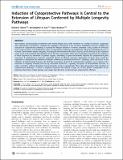Induction of Cytoprotective Pathways Is Central to the Extension of Lifespan Conferred by Multiple Longevity Pathways
Author(s)
Carr, Christopher E.; Shore, David E.; Ruvkin, Gary
DownloadShore-2012-Induction of Cytopro.pdf (680.4Kb)
PUBLISHER_CC
Publisher with Creative Commons License
Creative Commons Attribution
Terms of use
Metadata
Show full item recordAbstract
Many genetic and physiological treatments that extend lifespan also confer resistance to a variety of stressors, suggesting that cytoprotective mechanisms underpin the regulation of longevity. It has not been established, however, whether the induction of cytoprotective pathways is essential for lifespan extension or merely correlated. Using a panel of GFP-fused stress response genes, we identified the suites of cytoprotective pathways upregulated by 160 gene inactivations known to increase Caenorhabditis elegans longevity, including the mitochondrial UPR (hsp-6, hsp-60), the ER UPR (hsp-4), ROS response (sod-3, gst-4), and xenobiotic detoxification (gst-4). We then screened for other gene inactivations that disrupt the induction of these responses by xenobiotic or genetic triggers, identifying 29 gene inactivations required for cytoprotective gene expression. If cytoprotective responses contribute directly to lifespan extension, inactivation of these genes would be expected to compromise the extension of lifespan conferred by decreased insulin/IGF-1 signaling, caloric restriction, or the inhibition of mitochondrial function. We find that inactivation of 25 of 29 cytoprotection-regulatory genes shortens the extension of longevity normally induced by decreased insulin/IGF-1 signaling, disruption of mitochondrial function, or caloric restriction, without disrupting normal longevity nearly as dramatically. These data demonstrate that induction of cytoprotective pathways is central to longevity extension and identify a large set of new genetic components of the pathways that detect cellular damage and couple that detection to downstream cytoprotective effectors.
Date issued
2012-07Department
Massachusetts Institute of Technology. Department of Earth, Atmospheric, and Planetary SciencesJournal
PLoS Genetics
Publisher
Public Library of Science
Citation
Shore, David E., Christopher E. Carr, and Gary Ruvkun. “Induction of Cytoprotective Pathways Is Central to the Extension of Lifespan Conferred by Multiple Longevity Pathways.” Ed. Stuart K. Kim. PLoS Genetics 8.7 (2012).
Version: Final published version
ISSN
1553-7390
1553-7404